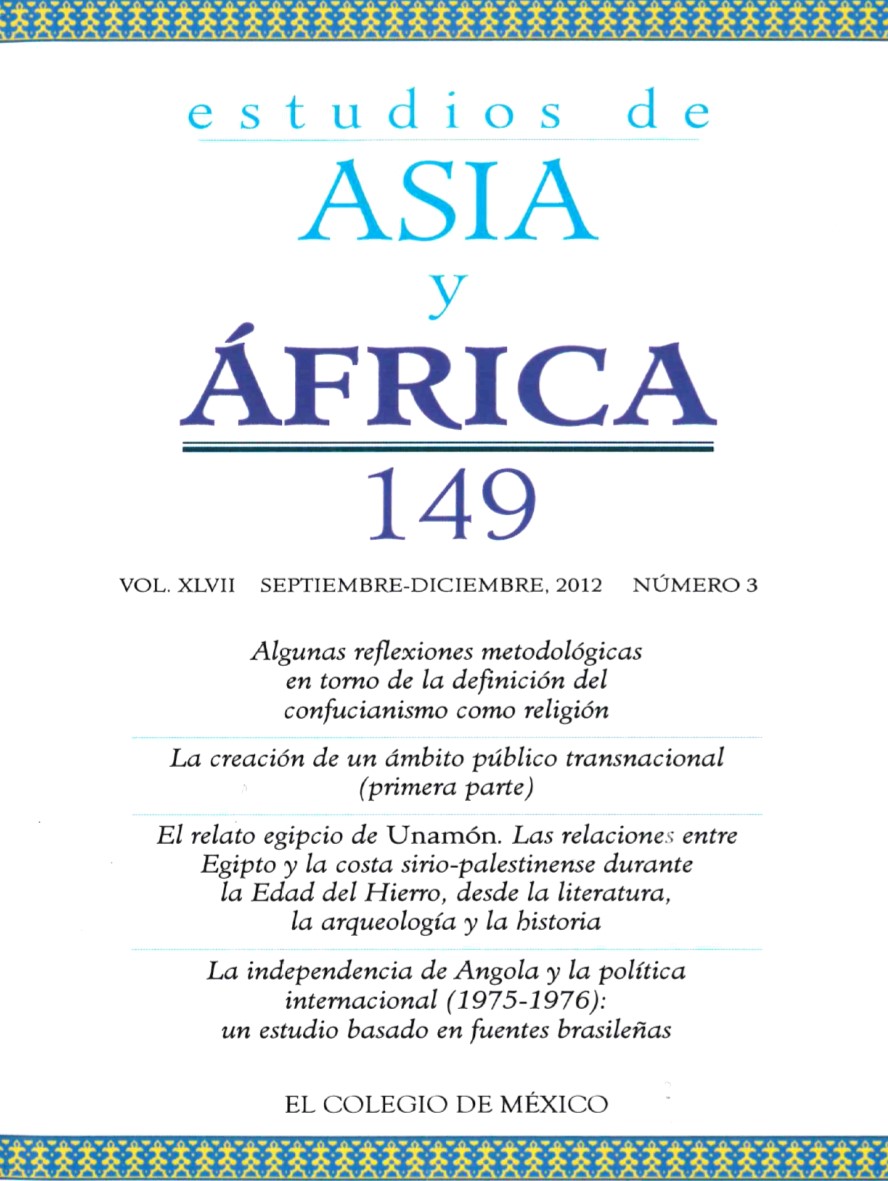Resumen
La propuesta del presente artículo consiste en analizar las relaciones entre Egipto y la costa sirio-palestinense durante la Edad del Hierro I. El relato literario de Unamón —en el que se narra el viaje que este funcionario del Estado egipcio emprende hacia las costas del Líbano— ha sido tomado como fuente histórica del periodo por muchos historiadores, considerando los rasgos que allí se presentan como distintivos de la relación entre estas regiones. Sin embargo, intentaremos aquí poner en discusión este uso, planteando, por un lado, algunas consideraciones sobre el carácter de las fuentes y el trabajo que el historiador debe hacer sobre ellas, y, por otro, rastreando referencias arqueológicas. Intentaremos así generar una tensión entre lo expresado en el texto literario y lo evidenciado a partir de los restos materiales, considerando el primero como un recurso válido de análisis en la medida en que por sus características y marcos de producción puede ofrecer diferentes expresiones sobre temáticas y preocupaciones de una sociedad específica.Referencias
Albright, William F., “Further Light on the History of Middle-Bronze Byblos”, Bulletin of the American Schools of Oriental Research, núm. 179, 1965, pp. 38-43.
Assmann, Jan, “Cultural and Literary Texts”, en G. Moers (ed.), Definitely: Egyptian Literature. Proceedings of the Symposium “Ancient Egyptian Literature: History and Forms”, Los Angeles, March 24-26, 1995, Gotinga, Lingua Aegyptia Studia Monographica 2, 1999, pp. 1-15.
Åström, Paul, “Trade in the Late Cypriot Bronze Age”, en E. Peltenburg (ed.), Early Society in Cyprus, Edimburgo, Edinburgh University Press, 1989, pp. 202-208.
Aubet, María Eugenia, Comercio y colonialismo en el Próximo Oriente Antiguo. Los antecedentes coloniales del III y II milenios a.C., Barcelona, Bellaterra Arqueología, 2007.
Baines, John, “On Wenamun as a Literary Text”, en J. Assmann y E. Blumenthal (comps.), Literatur und Politik im pharaonischen und ptolemäischen Ägypten, El Cairo, Institut Français d’Archéologie Orientale, Bibliothèque d’Étude 127, 1999, pp. 209-233.
Beitzel, Barry J., “The Via Maris in Literary and Cartographic Sources”, The Biblical Archaeologist, vol. 54, núm. 2, 1991, pp. 64-75.
Edgerton, William F. y John A. Wilson, Historical Records of Ramses III. The Texts in Medinet Habu. Volumes I and II, Chicago, The University of Chicago Press, 1986.
Edwards, Iowerth Eiddon Stephen (ed.), The Cambridge Ancient History, vol. I, part II, Early History of the Middle East, Cambridge, Cambridge University Press, 1971.
Galán, José Manuel, Cuatro viajes en la literatura del antiguo Egipto, Madrid, Consejo Superior de Investigaciones Científicas, 1998.
____________, El imperio egipcio. Inscripciones, ca. 1550-1300 a.C., Madrid, Trotta, 2002.
Gardiner, Alan H., Gramática egipcia, Valencia, Ediciones Lepsius, 1993 [1927].
____________, Late Egyptian Stories, Bruselas, Bibliotheca Aegyptiaca I, 1932.
Gilboa, Ayelet, “Sea Peoples and Phoenicians along the Southern Phoenician Coast: A Reconciliation: An Interpretation of Šikila (SKL) Material Culture”, Bulletin of the American Schools of Oriental Research, núm. 337, 2005, pp. 47-78.
____________, “The Significance of Iron Age ‘Wavy Band’ Pithoi along the Syro-Palestinian Littoral”, en S. R. Wolff (ed.), Studies in the Archaeology of Israel and Neighboring Lands. In Memory of Douglas L. Esse, Chicago, The Oriental Institute of the University of Chicago, 2001, pp. 163-174.
Goedicke, Hans, The Report of Wenamun, Baltimore, The Johns Hopkins University Press, 1975.
____________, “The Iron Men in Egypt”, en T. Bács (ed.), A Tribute to Excellence. Sudies offered in Honour of Ernő Gaál, Ulrich Luft and László Török, Budapest, Studia Aegyptiaca XVII, 2002, pp. 245-251.
Helck, Wolfgang, “Wenamun”, en W. Helck y W. Westendorf (eds.), Lexicon der Ägyptolgie. Band VI, Wiesbaden, Otto Harrassowitz, 1986, cols. 1215-1217.
Lefebvre, Gustave, Mitos y cuentos egipcios de la época faraónica, traducción del francés de José Miguel Serrano Delgado, Madrid, Akal, 2003 [1948].
Lichtheim, Miriam, Ancient Egyptian Literature. A Book of Readings, vol. II: The New Kingdom, Berkeley, University of California Press, 1976.
Liverani, Mario, El Antiguo Oriente. Historia, sociedad y economía, Barcelona, Crítica, 1995.
____________, Relaciones internacionales en el Próximo Oriente Antiguo, 1600-1100 a.C., Barcelona, Bellaterra Arqueología, 2003.
López, Jesús, Cuentos y fábulas del Antiguo Egipto, Barcelona, Editorial Trotta, 2004.
Maspero, Gaston, Popular Stories of Ancient Egypt, Nueva York, Oxford University Press, 2002 [1882].
Mazar, Amihai, Archaeology of the Land of the Bible. 10000-586. B.C.E., Nueva York, Doubleday, 1990.
Montet, Pierre, “Un Egyptien, roi de Byblos, sous la XIIe dynastie Étude sur deux scarabées de la collection de Clercq”, Syria, t. 8, fasc. 2, 1927, pp. 85-92.
Niehr, Herbert, “Some Aspects of Working with the Textual Sources”, en L. L. Grabbe (ed.), Can a “History of Israel” Be Written?, Londres, T&T Clark International, 2004 [1997], pp. 156-165.
Parkinson, Richard, The Tale of Sinuhé and Other Egyptian Poems, 1940-1640 B.C., Oxford, Oxford University Press, 1998.
Pritchard, James B., La sabiduría del Antiguo Oriente, Barcelona, Ediciones Garriga, 1966.
Sandars, Nancy K., Los pueblos del mar, Salamanca, Oberón, 2005.
Serrano Delgado, José Miguel, Textos para la historia antigua de Egipto, Madrid, Cátedra, 1993.
Simpson, William Kelly, The Literature of Ancient Egypt, New Heaven, Yale University Press, 2003 [1973].
Spens, Renaud de, “Droit International et Commerce au Début de la XXIe Dynastie. Analyse Juridique du Rapport d’Ounamon”, en N. Grimal y B. Menu (eds.), Le commerce en Égypte ancienne, El Cairo, Institut Français d’Archéologie Orientale, Bibliothèque d’Étude 121, 1998, pp. 105-126.
Stern, Ephraim, “New Evidence from Dor for the First Appearance of the Phoenicians along the Northern Coast or Israel”, Bulletin of the American Schools of Oriental Research, núm. 279, 1990, pp. 27-34.
Stieglitz, Robert R., “The Geopolitics of the Phoenician Litoral in the Early Iron Age”, Bulletin of the American Schools of Oriental Research, núm. 279, 1990, pp. 9-12.
Weinstein, James, “Levantine Peoples (Iron Age)”, en K. Bard (ed.), Encyclopedia of the Archaeology of Ancient Egypt, Nueva York, Routledge, 1999, pp. 532-535.
Esta obra está bajo una licencia internacional Creative Commons Atribución-NoComercial-SinDerivadas 4.0.
Derechos de autor 2022 Estudios de Asia y África



